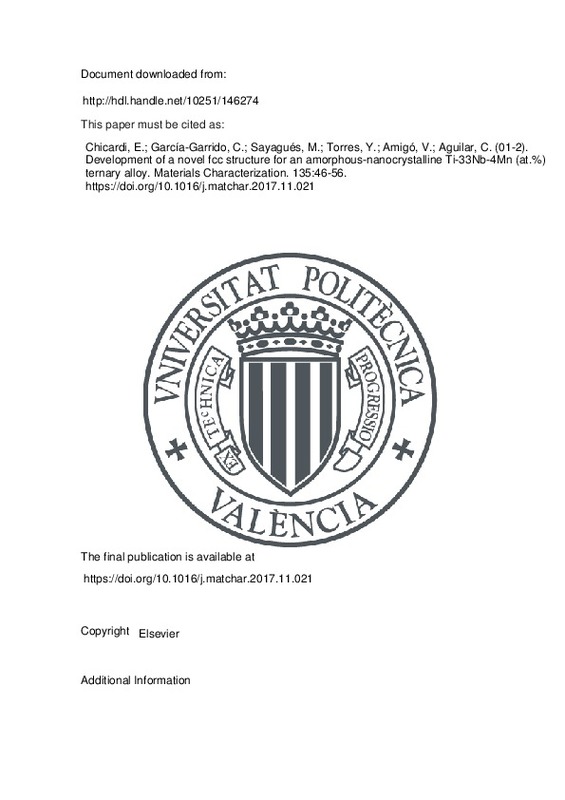JavaScript is disabled for your browser. Some features of this site may not work without it.
Buscar en RiuNet
Listar
Mi cuenta
Estadísticas
Ayuda RiuNet
Admin. UPV
Development of a novel fcc structure for an amorphous-nanocrystalline Ti-33Nb-4Mn (at.%) ternary alloy
Mostrar el registro sencillo del ítem
Ficheros en el ítem
| dc.contributor.author | Chicardi, Ernesto
|
es_ES |
| dc.contributor.author | García-Garrido, C.
|
es_ES |
| dc.contributor.author | Sayagués, M.J.
|
es_ES |
| dc.contributor.author | Torres, Y.
|
es_ES |
| dc.contributor.author | Amigó, Vicente
|
es_ES |
| dc.contributor.author | Aguilar, C.
|
es_ES |
| dc.date.accessioned | 2020-06-13T03:32:16Z | |
| dc.date.available | 2020-06-13T03:32:16Z | |
| dc.date.issued | 2018-01 | es_ES |
| dc.identifier.issn | 1044-5803 | es_ES |
| dc.identifier.uri | http://hdl.handle.net/10251/146274 | |
| dc.description.abstract | [EN] In this work, a novel amorphous-nanocrystalline titanium-niobium-manganese solid solution ternary alloy with a Ti-33Nb-4Mn (at.%) nominal composition was developed by a High-Energy Mechanical Alloying. Nb and Mn were added to the elemental Ti as a beta-phase (bcc) stabilizer and an amorphization promoter, respectively. The system evolved from the elemental Ti, Nb and Mn raw materials to a body centred cubic (bcc) TiNbMn alloy and, finally, to the formation of an original and stable face centred cubic (fcc) nanocrystalline TiNbMn alloy, not reported until now, at short milling time (20 h). This alloy remains invariant until 120 h. In turn, the partial amorphization of the system occurs and increases until at intermediate milling time (80 h). The production of both original fcc and the amorphous TiNbMn alloy may be beneficial for reducing the Young's modulus and improving the mechanical strength pursued for the Ti alloy. The optimal milling time respect to the amorphization, nanocrystalline size and Fe mount from milling media was 60 h and 80 h (TiNbMn60h and TiNbMn80h), with > 50 wt% of an amorphous phase and a crystalline domain size of approximately 5 nm. | es_ES |
| dc.description.sponsorship | This work was supported under postdoctoral grant no. 3150060, which is financed by the FONDECYT fund (Government of Chile). | es_ES |
| dc.language | Inglés | es_ES |
| dc.publisher | Elsevier | es_ES |
| dc.relation.ispartof | Materials Characterization | es_ES |
| dc.rights | Reserva de todos los derechos | es_ES |
| dc.subject | Ti alloy | es_ES |
| dc.subject | Niobium | es_ES |
| dc.subject | Manganese | es_ES |
| dc.subject | Amorphous | es_ES |
| dc.subject | Nanocrystalline | es_ES |
| dc.subject | Mechanical alloying | es_ES |
| dc.subject.classification | CIENCIA DE LOS MATERIALES E INGENIERIA METALURGICA | es_ES |
| dc.title | Development of a novel fcc structure for an amorphous-nanocrystalline Ti-33Nb-4Mn (at.%) ternary alloy | es_ES |
| dc.type | Artículo | es_ES |
| dc.identifier.doi | 10.1016/j.matchar.2017.11.021 | es_ES |
| dc.relation.projectID | info:eu-repo/grantAgreement/FONDECYT//3150060/CL/DESARROLLO Y CARACTERIZACIÓN DE ESPUMAS DE ALEACIONES AMORFAS BASE TITANIO PARA APLICACIONES BIOMÉDICAS/ | es_ES |
| dc.rights.accessRights | Abierto | es_ES |
| dc.contributor.affiliation | Universitat Politècnica de València. Departamento de Ingeniería Mecánica y de Materiales - Departament d'Enginyeria Mecànica i de Materials | es_ES |
| dc.description.bibliographicCitation | Chicardi, E.; García-Garrido, C.; Sayagués, M.; Torres, Y.; Amigó, V.; Aguilar, C. (2018). Development of a novel fcc structure for an amorphous-nanocrystalline Ti-33Nb-4Mn (at.%) ternary alloy. Materials Characterization. 135:46-56. https://doi.org/10.1016/j.matchar.2017.11.021 | es_ES |
| dc.description.accrualMethod | S | es_ES |
| dc.relation.publisherversion | https://doi.org/10.1016/j.matchar.2017.11.021 | es_ES |
| dc.description.upvformatpinicio | 46 | es_ES |
| dc.description.upvformatpfin | 56 | es_ES |
| dc.type.version | info:eu-repo/semantics/publishedVersion | es_ES |
| dc.description.volume | 135 | es_ES |
| dc.relation.pasarela | S\346940 | es_ES |
| dc.contributor.funder | Fondo Nacional de Desarrollo Científico y Tecnológico, Chile | es_ES |







![[Cerrado]](/themes/UPV/images/candado.png)

